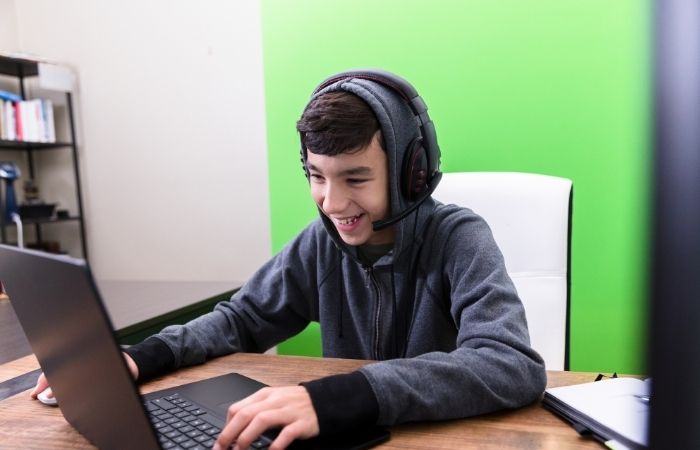Social Games
Can Video Games Be A Useful Learning Tool?

Many believe that video games definitely have the potential to become engaging and integrated learning tools that promote ideas and enhance soft skills.
Keeping students engaged in the classroom environment is an ongoing challenge and by using creativity and innovation, however, even some professional essay writers like Joan Young from AdvancedWriters.com believe it is possible to provide interesting learning experiences which can make learning exciting for students of varying ages and this can be done using video games and gaming.
Video games can be a useful learning tool in the home as well as in the classroom, and we will take a look at how they do this.
Learning Traditionally
Usually, the games that we play i.e. board games such as Snakes and Ladders or Cluedo, card games such as poker, or physical games such as football or rugby, have usually been enjoyed with friends or family as an activity or to build relationships. We have always used games to teach us how to play alone, they teach us how to play as part of a team and also promote healthy competition. The question to ask is whether games are able to achieve more than this. We tend to be drawn to games irrespective of our age and games are able to keep us focused and interested and therefore are a perfect medium when it comes to learning. Essentially, games offer fun as well as the opportunity to develop new skills. The kinds of skills we pick up when playing games include: teamwork and problem-solving skills. Mathematical skills, motor skills, interpersonal skills, and strategic skills, to name but a few. Therefore, if games are created for learning purposes, it is clear to see how they can help those playing achieve new skills.
How Else Video Games Can Help
Below we will list the other ways video games can be a useful learning tool:
Attention span
Studies have revealed that an average adult’s attention span is approximately 20 minutes. Therefore, a challenge that teachers face is to keep students engaged in a classroom session for up to one hour when their attention span may be shorter. This issue is even harder when students are even younger. For instance, primary-aged students have an attention span of up to 10 minutes.
Video games are able to help us focus and concentrate on playing and winning a game. This has led ed-tech companies to think about how video games may be used in education to help keep students’ attention and engage them when it comes to their learning. The research so far has shown that this can work.
Imagination and creativity in video games
In some education systems across the world, students are expected to not ask questions and stay quiet. This goes against many opinions of those who are experts in the field of education as they believe children need to question, be imaginative, and creative. Video games are a great way of allowing children to express themselves as well as be analytical and creative. Puzzles based on science help to nurture young coders, innovators, mathematicians, and scientists.
Video Games and STEAM
In the past, many teaching methods have been used when it comes to teaching subjects such as science and mathematics. These include experiments, projects, and activities that have all served their role. As technology continues to advance, virtual, digital, and online educational tools have moved from optional to necessity.
These days many institutions have moved with the times when teachers use video conferencing to teach. Science and mathematics are practical subjects that students need all of their senses to carry out and learn concepts for both subjects. These senses include spatial, tactile, audio, and visual. It is not enough to explain scientific and mathematical concepts using video conferences as it becomes difficult for students to understand the concepts and apply them to real life if this is the only method of teaching.
Gaming, whether it is virtual or physical, can help students to enhance learning via visual, audio, and kinesthetic methods. For instance, when learning mathematical concepts, other learning platforms can be used to manipulate real-life scenarios when it comes to learning. It also allows students to practice solving word problems through various solutions. Apps are able to provide instant feedback, so students will feel motivated and encouraged.
Video Games as a Holistic Learning Tool
For happiness and growth, holistic skills are crucial. All skills associated with holistic learning have been found in video games. These include academic skills, soft skills, job skills, survival skills, spiritual health job skills, and mental health. Through video games, we can also learn about teamwork, leadership, strategy, patience, and much more.
Teachers can use video games to ensure that learning using technology is holistic by asking students to talk about what they are learning using the video game to develop their social skills. Younger students can be mentored by older students as they can be taught how to use video games and develop their leadership skills. It is clear to see that holistic growth has endless opportunities if video games are used in learning.
Video Games and Learning – The Conclusion
As the number of educational games continues to grow, educators will need to think carefully about how they will incorporate them into the classroom to create an effective and stimulating learning environment. Educational apps, games, and other platforms provide an amazing glimpse into the future where students will benefit from the individualized attention that is required when it comes to their learning. It becomes apparent that video games and similar products help to boost a student’s understanding, attention, creativity, and motivation.
Gaming in general has the ability to become a useful and integrated learning tool that will not only enhance a student’s soft skills but also develop the academic aspects such as problem-solving, literacy, elements of numeracy, analytical reasoning, and spatial intelligence. These are just a few of the kinds of skills that can be gained by using gaming in the learning environment.
Browser Games
How to Master 96% RTP Slot

Online fruit machines that you can play in the real money mode at licensed and regulated websites controlled by reputable operators are now more popular than ever, and there are many reasons why, which I will reveal here.
I will also be discussing some of the best ways to master online fruitys, especially those with an average 96.00% Return to Player percentage (RTP%) payout rate.
The important thing to remember about online fruitys is that there is no proven strategy that can help you win because winning all boils down to pure luck.
However, there are some useful strategies I think everyone who wants to sample this kind of content should know, which can bring them up to speed in no time. Armed with this knowledge, you can quickly become a master of online fruitys when you next play them on your favourite website.
What exactly is RTP?
The RTP% (Return to Player percentage) payout rate can be calculated for each online casino game.
In short, this value tells us roughly how much an online fruity will pay back after, say, $/€/£100, $/€/£1,000, $/€/£10,000, $/€/£100,000, or $/€/£1,000,000 has been spent [combined] by all those people who spend money spinning the reels on any given fruity.
For example, let’s just say that participants spend $/€/£10,000.00 (or equivalent currency value) combined on the popular Chicago Gold online fruit from Pear Fiction Studios in a period of four weeks, and those same participants, on average, received $/€/£96,000.00 back in winnings.
This basic information tells us that the Chicago Gold fruity had an average 96.00% RTP payout rate over this four-week period. The casino would keep the remaining 4.00% (the house edge) or $/€/£4,000.00 as profit.
That’s the easiest way for me to describe how online fruity RTP works, which most of you should be able to understand. I also found a great description on the globally renowned Johnslots (www.johnslots.com/en/) review site that I can recommend checking out for high RTP slot machines.
What is considered a good RTP for online fruitys, and why does it matter?
The higher the RTP% payout rate, the more likely it is that you will win. For example, a 99.50% RTP fruity will pay back more than one with a 91.25% RTP payout rate for every $/€/£100 wagered. When I found this out, I must admit, I would only play online fruitys with a 96.00% or higher RTP payout rate.
It matters because, mathematically speaking, high RTP online fruitys are more likely to pay than low RTP fruitys.
However, the other important thing to remember is that there might be 1,000 to 1,000,000 people all playing the same online fruity at the same time, and you are not guaranteed to win back $/€/£96.00 if you spend $/€/£100.00.
Winning is all still down to lady luck. For example, I have deposited $/€/£10 or $/€/£20 many times in the past at my favourite sites and have won $/€/£60 to $/€/£100 from that initial deposit on one fruity. Other times, I have spent $/€/£50 to $/€/£100 on one fruit and won nothing.
That’s just how it is. Some gamblers may spend just $/€/£1.00 to $/€/£10.00 and win $/€/£100 or more in those 1-10 spins, and other users might spend $/€/£100 and only win $/€/£1.00 to $/€/£10 in over 500 spins.
A good RTP% payout rate in an online fruity is considered 96.00% or above.
The average is considered to be between 93.00% and 95.99%, and the lowest is anything below 93.00%. In other words, most online fruitys today have an average 93.00% to 98.00% RTP payout rate.
Which online fruitys have a 96.00% RTP payout rate in 2024?
Apart from the Chicago Gold online fruity, many other hit titles have the same payout rate. Examples include the following top-rated titles that you may want to check out, which you can play on a desktop computer or smartphone provided you are of legal age in your country:
- Esqueleto Explosivo online fruity by Thunderkick
- Frogblox online fruity by ELK Studios
- Friends online fruity by [WMS] and SG Digital
- Rainbow Riches Megaways online fruity by Barcrest and SG Digital
- Aliya’s Wishes online fruity by Fortune Factory Studios and Games Global
There are many others out there, but I thought I would mention these as these are the ones where I have had a few decent-sized wins.
How to master 96% RTP fruitys
The easiest way to master any online fruity is to keep playing it. When trying a new fruity for the first time, I’ve always found that I will reduce the stake to the minimum amount, which is usually $/€/£0.10 or $/€/£0.20 just to test the waters and find out if I like it or not.
The other quickest way to bring yourself up to scratch is to head straight to the paytable to find out everything you need to know about the fruity you are about to play.
The important information I look for in the paytable is the RTP payout rate, the value of the regular symbols, what the scatter, bonus, and wild symbols look like, and how the in-play bonus features, free spins bonuses, and second screen bonus rounds work when they are triggered.
Once you have mastered one online fruity, learned everything there is to know about it, and figured out when it’s in a good mood (paying) or bad mood (not paying), you can apply those same strategies to all other online fruitys you decide to play.
When playing online fruitys, whether it’s one you have mastered or one you are trying for the first time, the most important thing I mustn’t forget to mention is to gamble responsibly.
The best way to do this is to start by setting a budget and then setting either a deposit limit, spending limit, session time reminder, or win/loss limit.
Browser Games
5 Essential Banking Tips for Playing Online Casino in Australia

Engaging with Australian online casinos can be a thrilling and potentially lucrative venture. However, navigating the complexities of online punting transactions is crucial for ensuring a seamless and secure gaming experience.
This article provides expert advice to enhance online casino play and effectively manage finances. Whether a novice or seasoned player, these insights will contribute to a more enjoyable gaming journey.
Tip 1: Choose a Reliable Payment Method
Selecting a secure and dependable payment method is paramount when engaging in online punting. Australian players have access to a variety of payment options, including:
Credit cards
- E-wallets
- Bank transfers
- Cryptocurrencies
- When it comes to selecting the best remittance methods for online betting, there are several options available, each with its own advantages and potential drawbacks. As you explore new reliable online casinos, consider how different payment methods align with your financial management strategy. Here’s a breakdown of the most popular payment methods according to the experts of Stakers:
Visa and MasterCard
- Popular choices due to convenience and robust security measures.
- Recent regulations may impose restrictions on gambling trades.
E-wallets (ecoPayz, Neosurf, MuchBetter)
- Favoured for rapid transaction times and lower fees.
- Offer additional security by keeping banking information confidential.
Bank Transfers
- Highly secure option.
- Can be slower for withdrawals.
- Reliable choice for larger transactions.
Cryptocurrencies (Bitcoin, Ethereum)
- Provide anonymity and quick processing times.
- Increasingly popular among digital punting enthusiasts.
Tip 2: Set a Gambling Budget
Establishing a gambling budget is crucial for managing expenditure. It is easy to be swept up in the excitement of digital wagering, so setting a budget helps prevent overspending. Evaluating disposable income and establishing daily, weekly, or monthly limits that align with financial situations ensures that punting remains an enjoyable activity without negatively impacting financial well-being. Many virtual wagering parlours offer tools to assist in managing spending, such as deposit limits or notifications when a certain threshold is reached.
Tip 3: Understand Casino Terms and Conditions
Before making a deposit, it is vital to thoroughly review the terms and conditions of the betting establishment. Key aspects to consider include:
- Minimum deposit
- Withdrawal amounts
- Processing times
- Any associated fees
For instance, some betting establishments may impose fees for specific payment methods or restrict withdrawal amounts. It is also essential to understand wagering requirements and conditions related to bonuses and promotions. These rules dictate how many times a bonus must be wagered before withdrawing winnings.
Tip 4: Utilise Responsible Gambling Tools
Reputable web-based wagering parlours offer responsible wagering tools to help players manage their punting behavior. Features such as deposit limits, self-exclusion options, and reality checks promote responsible betting and ensure a controlled and enjoyable experience.
| Feature | Description | Benefit |
| Deposit Limits | Allows setting a maximum amount for deposits within a specified period. | Helps stay within budget. |
| Self-Exclusion Options | Enables a temporary break from gambling if needed. | Provides a necessary pause to regain control. |
| Reality Checks | Provides reminders of how long one has been playing. | Aids in effective time management. |
Tip 5: Keep Track of Transactions and Monitor Account Activity
Maintaining accurate records of all deposits, withdrawals, and bonus transactions is essential for effective financial management. Using spreadsheets or financial apps to meticulously track all transactions ensures control over spending. Regularly monitoring account activity helps identify any suspicious or unauthorised activity, which should be promptly reported to the casino’s customer service.
Vigilance in monitoring transactions ensures the security and integrity of funds. Reporting anomalies or suspicious transactions immediately to both the betting establishment and the payment provider safeguards accounts and funds from potential fraud.
Conclusion
Adhering to these banking tips enhances the digital casino experience, ensuring it remains safe and enjoyable. Choosing reliable payment methods, setting a budget, understanding terms and conditions, using responsible gambling tools, and keeping meticulous records of transactions allows confident navigation in the world of virtual gambling. Staying vigilant and proactive maximises the online casino journey, always prioritising safe and responsible gambling practices.
Casino
The Live Blackjack Journey: From Beginner to Pro

All the traditional online casino platforms come with a bunch of games. The game section has lots of slot games as well as some table game titles. However, a live casino section is also present with games like live roulette, poker, baccarat, and blackjack.
Live blackjack is a popular rendition of the game. Players from all over the world visit casino sites to enjoy it. You might be new to the title, but you needn’t worry as learning it is a process that takes time. When you focus on the right things, you’ll become a live blackjack pro.
Creating an Account on the Right Website
As a beginner, you need to understand that the right platform will cover all your needs and wants. To find one look for a license at the bottom of the webpage. Then dive into the games section, visit the live games selection, and see if it comes with several blackjack online titles available. The array of bonuses will also help you in your gaming sessions, so consider them too. For a smooth experience look for your favorite payment method in the payment methods sections. Don’t forget about customer support and security before creating an account at the right website.
Using Blackjack Demos as Practice Tools
Live blackjack doesn’t come with a demo version. Instead, you’ll need to find the specific version as a table game. When you do, you can go for the demo variant of the title. The demo version lets you learn the basics without having to worry about the consequences of mistakes. In other words, you can enjoy the game while making mistakes, as you won’t suffer for it. While you’re learning the basics, you’ll also need to know how to become a disciplined player.
Becoming Disciplined
There are two sides to disciplined live blackjack players: budget and attitude management. The former is a skill that will grant you the tools to manage wins and losses. You will split it into pieces per session, and you will look to increase it by dedicating a piece of your winnings. Losses will reduce it, but don’t go playing the game looking to earn your lost money back. The latter is an essential skill that stops you from rash decisions such as chasing losses. With the right attitude, you’ll grow as a live blackjack player.
Going for the Real-Money Experience
The real-money experience will teach you what it feels like to play live blackjack for real. The more you practice, the better you’ll become. By putting your skills to the test, you’ll take it to the next level, and stay ahead of the competition.
To Sum Up
Live blackjack is a game of skill that beginners need to master if they’re to become pros. They need to find the right platform and practice with demo blackjack versions. Becoming disciplined players is another vital aspect of the real-money live blackjack experience. As time passes and they practice regularly, they’ll become live blackjack pros in no time.
-

 Guides5 years ago
Guides5 years ago6 Proven Ways to Get more Instagram Likes on your Business Account
-

 Mainstream10 years ago
Mainstream10 years agoBioWare: Mass Effect 4 to Benefit From Dropping Last-Gen, Will Not Share Template With Dragon Age: Inquisition
-

 Mainstream6 years ago
Mainstream6 years agoHow to Buy Property & Safe Houses in GTA 5 (Grand Theft Auto 5)
-

 Casual2 years ago
Casual2 years ago8 Ways to Fix Over-Extrusion and Under-Extrusion in 3D Printing
-

 Mainstream12 years ago
Mainstream12 years agoGuild Wars 2: The eSports Dream and the sPvP Tragedy
-

 Guides10 months ago
Guides10 months agoFree Fire vs PUBG: Comparing Graphics, Gameplay, and More
-

 iOS Games2 years ago
iOS Games2 years agoThe Best Basketball Games for IOS
-

 Gaming News1 year ago
Gaming News1 year agoSwiping, Tapping, and Tilting: How Mobile Games Are Played Today






